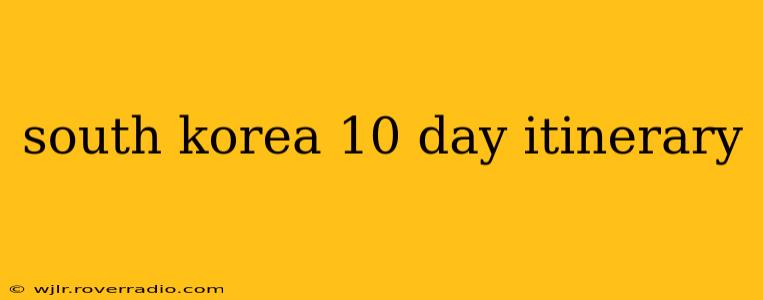South Korea, a vibrant blend of ancient traditions and futuristic technology, offers a captivating experience for travelers. This 10-day itinerary balances iconic landmarks with off-the-beaten-path gems, ensuring a memorable journey through this fascinating country. This itinerary focuses on Seoul and surrounding areas, allowing for a deeper exploration. For a more expansive trip, consider extending your stay.
Day 1: Arrival in Seoul & Myeongdong Exploration
Upon arrival at Incheon International Airport (ICN), take the Airport Railroad Express (AREX) to Seoul Station. Check into your hotel and begin your adventure in Myeongdong, a bustling shopping district known for its cosmetics, street food, and vibrant atmosphere. Indulge in delicious Korean street food like tteokbokki (spicy rice cakes) and hotteok (sweet pancakes). In the evening, enjoy the dazzling neon lights and bustling energy of the area.
Day 2: Historic Seoul: Gyeongbokgung Palace & Bukchon Hanok Village
Immerse yourself in history at Gyeongbokgung Palace, the largest and most stunning of Seoul's five grand palaces. Witness the changing of the guard ceremony and explore the palace grounds. Afterwards, wander through Bukchon Hanok Village, with its charming traditional Korean houses (hanoks), tea houses, and artisan shops. Enjoy a traditional Korean tea ceremony for a truly immersive cultural experience.
Day 3: DMZ (Demilitarized Zone) Day Trip
Take a guided tour to the Demilitarized Zone (DMZ), the border between North and South Korea. This impactful experience offers a glimpse into the Korean War and the divided peninsula. Note that tours require pre-booking and typically involve a full day. Be prepared for a sobering but historically significant experience.
Day 4: Insadong & N Seoul Tower
Explore Insadong, known for its traditional crafts, tea houses, and art galleries. Browse through unique souvenirs and enjoy a relaxing tea break. Ascend N Seoul Tower for panoramic views of the city, especially stunning at sunset. In the evening, explore the surrounding area of Namsan Hanok Village for more traditional architecture.
Day 5: Shopping & Entertainment: Gangnam & Olympic Park
Experience the modern side of Seoul in Gangnam, famous for its upscale shopping, entertainment venues, and stylish cafes. Visit the COEX Aquarium or the Starfield Library for a unique experience. Later, explore the vast Olympic Park, a legacy of the 1988 Seoul Olympics, offering beautiful green spaces perfect for a relaxing stroll.
Day 6: Suwon Hwaseong Fortress & Korean Folk Village
Take a day trip to Suwon to explore the magnificent Hwaseong Fortress, a UNESCO World Heritage site. This impressive fortress showcases Joseon Dynasty architecture and engineering. Afterwards, visit the Korean Folk Village, a living museum showcasing traditional Korean life and culture.
Day 7: Temples & Nature: Jogyesa Temple & Olympic Park
Visit Jogyesa Temple, the main temple of the Jogye Order of Korean Buddhism. Experience the serene atmosphere and learn about Buddhist traditions. Spend the afternoon relaxing and exploring more of Olympic Park, perhaps renting a bike or simply enjoying the peaceful surroundings.
Day 8: Art & Culture: Leeum, Samsung Museum of Art & National Museum of Korea
Explore Seoul's thriving art scene with visits to Leeum, Samsung Museum of Art, and the National Museum of Korea. These museums showcase a wide range of Korean and international art, providing an enriching cultural experience.
Day 9: Last-Minute Shopping & Farewell Dinner
Enjoy some last-minute souvenir shopping in areas like Namdaemun Market or Itaewon. In the evening, indulge in a special farewell dinner, savoring your favorite Korean dishes one last time.
Day 10: Departure
Depending on your flight schedule, enjoy a final Korean breakfast before heading to Incheon International Airport for your departure.
Frequently Asked Questions (FAQs)
H2: What is the best time to visit South Korea?
The best time to visit South Korea is during spring (April-May) and autumn (September-October) when the weather is pleasant and the crowds are smaller than during peak summer months.
H2: How much does a 10-day trip to South Korea cost?
The cost of a 10-day trip to South Korea varies depending on your travel style and preferences. Budget travelers can manage on around $1000-$1500 excluding flights, while more luxurious trips can easily exceed $3000+.
H2: What are some must-try Korean foods?
Must-try Korean foods include Kimchi, Bibimbap, Bulgogi, Korean BBQ, Japchae, and Tteokbokki. Don't be afraid to explore street food as well!
H2: What is the best way to get around South Korea?
Seoul has an excellent public transportation system, including a subway and bus network. For traveling outside of Seoul, high-speed KTX trains are efficient and convenient.
H2: Is it easy to navigate South Korea without knowing Korean?
While knowing some basic Korean phrases is helpful, English is spoken in tourist areas and many signs are in English. Translation apps are also extremely useful.
H2: What kind of visa do I need for South Korea?
Visa requirements depend on your nationality. Check the South Korean embassy or consulate website for specific visa information for your country.
This itinerary is a suggestion and can be adapted to your interests and preferences. Remember to book accommodations and transportation in advance, especially during peak season. Enjoy your incredible journey through South Korea!
